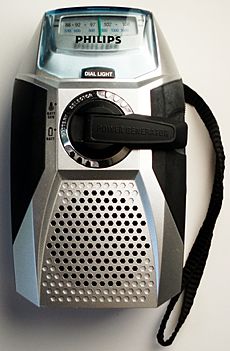Clockwork radio facts for kids
A clockwork radio is a special kind of radio that gets its power from a spring. You make the spring tight by winding a handle or crank. When the spring unwinds, it creates electricity to make the radio work.
These radios are super helpful, especially when there's no regular electricity. Imagine a big storm, a power outage, or if you live somewhere far away from power lines. Clockwork radios don't need batteries or wall sockets. They are also a good choice for the environment because they don't use disposable batteries, which can create waste and contain harmful metals.
Contents
How Do Hand-Powered Radios Work?
Hand-powered devices are tools that you operate with your own muscle power. They are great for emergencies when normal power might not be available. They are also useful in places where batteries are expensive or hard to find. Plus, they are a greener option than using batteries that you throw away.
Radios for Survival
During World War II, a special survival radio called the "Gibson Girl" was used. It had a hand-cranked generator to make power. This was important because regular batteries could stop working if stored for a long time. The only downside was that the person using it had to be strong enough to turn the crank. Both sides in the war created and used these survival radios.
Radios for Soldiers
In World War II, American soldiers sometimes used hand-crank generators like the GN-35 and GN-45. These generators powered their Signal Corps Radio sets. Winding the crank was hard work, but it made enough electricity for smaller radios to operate.
What is a Windup Radio?
A windup radio or clockwork radio is a radio that runs on human muscle power. It doesn't need batteries or electricity from the wall. Usually, you turn a crank on the radio's case. This winds up a spring inside, which then powers a small electric generator. A full winding can make the radio play for several hours. Sometimes, the generator might also charge a small battery inside the radio.
Hand-cranked radios have been around for a while, but they were mostly used by emergency services or the military. The modern clockwork radio was invented and patented in 1991 by a British inventor named Trevor Baylis. He wanted to create a radio that poor people in developing countries could use, especially where batteries were hard to get.
Windup radios are perfect for activities like camping or for emergency kits. They are also useful in remote areas where there's no electricity, or where it's hard to buy new batteries. If you have a radio that you don't use often, like at a vacation cabin, a windup radio is great because its power source won't go bad like regular batteries.
Many windup radios made for emergencies also come with extra features. These can include flashlights, blinking emergency lights, and even sirens. Some might also have other ways to get power, like using regular batteries, plugging into a car's cigarette lighter, or even solar cells that use sunlight.
Pedal-Powered Radios
The Pedal Radio (sometimes called Pedal Wireless) was a radio that got its power from a generator you operated with pedals, like a bicycle. It was invented by Alfred Traeger in Australia in 1929. He created it to help people living in remote Australian areas, called the outback, communicate by radio. At that time, there was no electricity, and batteries would have been too expensive. The Pedal Radio is considered a very important Australian invention.






